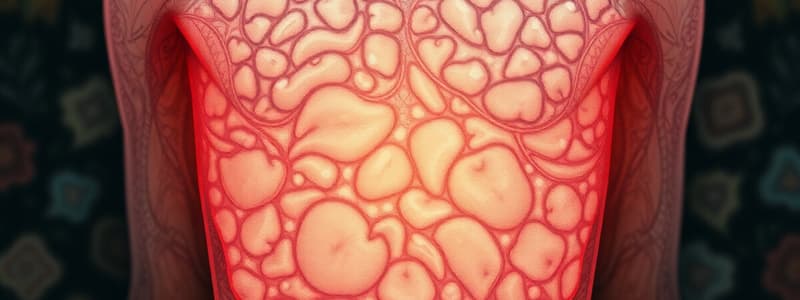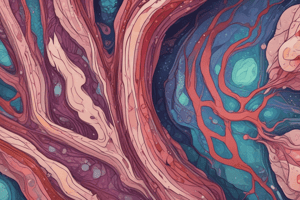Podcast
Questions and Answers
What is the primary function of simple cuboidal epithelium?
What is the primary function of simple cuboidal epithelium?
- Diffusion and filtration
- Secretion and absorption (correct)
- Protection against abrasion
- Transport of materials
Which of the following epithelia is classified as stratified?
Which of the following epithelia is classified as stratified?
- Simple squamous epithelium
- Simple columnar epithelium
- Pseudostratified columnar epithelium
- Stratified squamous keratinized epithelium (correct)
Which characteristic best describes simple squamous epithelium?
Which characteristic best describes simple squamous epithelium?
- Cytoplasm is thick and abundant
- Cells are tall and narrow
- Multiple layers of cells
- Cells have a flat nucleus resembling a bulge (correct)
What type of epithelial tissue would you find lining blood vessels?
What type of epithelial tissue would you find lining blood vessels?
Which of the following epithelia is NOT classified as simple epithelium?
Which of the following epithelia is NOT classified as simple epithelium?
What is the primary function of stratified squamous non-keratinized epithelium?
What is the primary function of stratified squamous non-keratinized epithelium?
Which cells are located in the deepest layer of stratified squamous keratinized epithelium?
Which cells are located in the deepest layer of stratified squamous keratinized epithelium?
What type of epithelium is found in areas subject to significant friction and abrasion?
What type of epithelium is found in areas subject to significant friction and abrasion?
What characterizes transitional epithelium?
What characterizes transitional epithelium?
In what location would you find stratified squamous keratinized epithelium?
In what location would you find stratified squamous keratinized epithelium?
What type of cell is predominantly found in the superficial layer of transitional epithelium?
What type of cell is predominantly found in the superficial layer of transitional epithelium?
Which type of epithelium consists of multiple layers but is not keratinized?
Which type of epithelium consists of multiple layers but is not keratinized?
Which type of gland releases a portion of the secreting cell along with the secretion?
Which type of gland releases a portion of the secreting cell along with the secretion?
What shape characterizes the secretory unit of an acinar gland?
What shape characterizes the secretory unit of an acinar gland?
In terms of the type of secretion, which gland primarily secretes a watery clear fluid?
In terms of the type of secretion, which gland primarily secretes a watery clear fluid?
Which of the following is an example of a unicellular gland?
Which of the following is an example of a unicellular gland?
Which gland accumulates its secretion within the cell and releases the entire cell as part of its secretion?
Which gland accumulates its secretion within the cell and releases the entire cell as part of its secretion?
What kind of glands are the gastric glands classified as based on their secretory unit shape?
What kind of glands are the gastric glands classified as based on their secretory unit shape?
Which of the following best describes mixed glands?
Which of the following best describes mixed glands?
What type of epithelium is characterized by umbrella shaped cells and is found in the ureter and urinary bladder?
What type of epithelium is characterized by umbrella shaped cells and is found in the ureter and urinary bladder?
Which type of secretion is produced by mucous glands?
Which type of secretion is produced by mucous glands?
Which glands primarily consist of clusters of secreting cells?
Which glands primarily consist of clusters of secreting cells?
Which glandular type releases hormones directly into the bloodstream without the use of ducts?
Which glandular type releases hormones directly into the bloodstream without the use of ducts?
Which type of epithelial cells primarily provide protection and are found in the conjunctiva?
Which type of epithelial cells primarily provide protection and are found in the conjunctiva?
What are the main functions of exocrine glands?
What are the main functions of exocrine glands?
What type of epithelium consists of two layers of cuboidal cells and is found in ducts of sweat glands?
What type of epithelium consists of two layers of cuboidal cells and is found in ducts of sweat glands?
Which gland classification is defined by having a duct system that discharges secretions onto an epithelial surface?
Which gland classification is defined by having a duct system that discharges secretions onto an epithelial surface?
What distinguishes simple glands from compound glands?
What distinguishes simple glands from compound glands?
Which of the following best describes the secretion process of endocrine glands?
Which of the following best describes the secretion process of endocrine glands?
Which cell type is commonly found in the deeper layers of stratified columnar epithelium?
Which cell type is commonly found in the deeper layers of stratified columnar epithelium?
Flashcards
Simple Squamous Epithelium
Simple Squamous Epithelium
A single layer of flat cells resting on a basement membrane. Cells are wider than tall, with a flattened nucleus. Allows for diffusion and filtration.
Simple cuboidal epithelium
Simple cuboidal epithelium
A single layer of cells with equal height and width, containing a centrally located, round nucleus. Function is secretion and absorption.
Epithelial classification
Epithelial classification
Epithelial tissues are categorized into types ('simple' or 'stratified') based on the number of cell layers.
Function of Simple Squamous
Function of Simple Squamous
Signup and view all the flashcards
Location of Simple Squamous
Location of Simple Squamous
Signup and view all the flashcards
Stratified Squamous Epithelium
Stratified Squamous Epithelium
Signup and view all the flashcards
Stratified Squamous Non-Keratinized Epithelium
Stratified Squamous Non-Keratinized Epithelium
Signup and view all the flashcards
Stratified Squamous Keratinized Epithelium
Stratified Squamous Keratinized Epithelium
Signup and view all the flashcards
Transitional Epithelium (Urothelium)
Transitional Epithelium (Urothelium)
Signup and view all the flashcards
Pseudostratified Ciliated Columnar Epithelium (Trachea)
Pseudostratified Ciliated Columnar Epithelium (Trachea)
Signup and view all the flashcards
Goblet Cells
Goblet Cells
Signup and view all the flashcards
Cilia
Cilia
Signup and view all the flashcards
Transitional Epithelium
Transitional Epithelium
Signup and view all the flashcards
Ureter Epithelium
Ureter Epithelium
Signup and view all the flashcards
Urinary Bladder Epithelium
Urinary Bladder Epithelium
Signup and view all the flashcards
Stratified Columnar Epithelium
Stratified Columnar Epithelium
Signup and view all the flashcards
Stratified Cuboidal Epithelium
Stratified Cuboidal Epithelium
Signup and view all the flashcards
Gland
Gland
Signup and view all the flashcards
Exocrine Gland
Exocrine Gland
Signup and view all the flashcards
Endocrine Gland
Endocrine Gland
Signup and view all the flashcards
Simple Gland
Simple Gland
Signup and view all the flashcards
Tubular gland
Tubular gland
Signup and view all the flashcards
Acinar gland
Acinar gland
Signup and view all the flashcards
Alveolar gland
Alveolar gland
Signup and view all the flashcards
Serous gland
Serous gland
Signup and view all the flashcards
Mucous gland
Mucous gland
Signup and view all the flashcards
Unicellular gland
Unicellular gland
Signup and view all the flashcards
Study Notes
Basic Tissues of the Human Body
- Tissues are groups of cells that share similar structures and functions, along with intercellular materials.
- Four main types of tissues are: epithelial, muscle, connective, and nervous.
Epithelial Tissue
- Consists of one or more layers of closely packed cells.
- Cells have minimal intercellular spaces.
- Lines pathways exposed to the external environment, including organs like the gastrointestinal, respiratory, and urogenital systems.
- Also lines serous body cavities (mesothelium), heart, blood vessels, and lymphatic vessels (endothelium).
- It's found in ducts and secretory elements of glands.
Characteristics/Features of Epithelial Cells
- Cellularity: Composed mainly of cells with little intercellular material between them.
- Polarity: Cells have different electrically charged molecules on their surfaces and sides; it helps them transport molecules selectively, allowing only specific molecules to pass from one side to another. Specific surfaces of cells dictate polarity.
- Attachment: Cells are attached to underlying basement membranes via hemidesmosomes.
- Avascularity: They lack blood vessels and are nourished by diffusion from the underlying capillaries.
- Innervation: They contain nerve endings.
- High Regeneration Capacity: Epithelial cells frequently are damaged or lost from abrasion, but they are quickly replaced.
Apical/Luminal/Basal Surfaces
- Apical Surface: Exposed to the external surface or internal body spaces.
- Basal Surface: The interface between epithelium and supporting tissues, with a non-cellular basement membrane. This structure supports tissues and regulates the passage of materials between epithelium and underlying supporting tissues.
Lateral Surfaces
- Structures like tight junctions, adherens junctions, desmosomes, and gap junctions connect these surfaces together. This strong cohesion allows communication between cells of epithelium, and regulates their functioning.
Functions of Epithelium
- Protection of underlying tissues from injury and abrasion.
- Secretion of mucus, hormones, and enzymes from glands
- Absorption of materials (e.g., in the intestinal tract or kidney tubules).
- Detecting sensations (e.g., in the olfactory epithelium of the nose and taste buds).
Classification of Epithelia
- Divided into simple or stratified based on the number of cell layers.
- Specific types of cells (simple squamous, simple cuboidal, simple columnar, pseudostratified columnar, stratified squamous, stratified cuboidal, stratified columnar, and transitional) provide the subtypes for simple and stratified epithelia.
Simple Epithelia
-
Simple squamous epithelium: One layer of flat cells; Found in alveoli of the lungs, capillaries, and Bowman's capsule.
-
Simple cuboidal epithelium: One layer of cube-shaped cells; Found in thyroid follicles, kidney tubules.
-
Simple columnar epithelium: One layer of tall, column-shaped cells; Found in stomach, intestines, uterine tube.
-
Pseudostratified columnar epithelium: Appear stratified but are single layers; Contains goblet cells and cilia; Located in the trachea
Stratified Epithelia
- Stratified squamous non-keratinized epithelium: Several cell layers with no keratin; found in the esophagus.
- Stratified squamous keratinized epithelium: Several layers with keratin; Found in skin (protection from water loss and friction).
- Stratified cuboidal epithelium: Two or more layers of cube-shaped cells; Found in ducts of sweat glands.
- Stratified columnar epithelium: Several layers with mostly columnar cells; Found in some ducts.
- Transitional epithelium: Varies in shape; Found in the urinary bladder and ureters (allows stretching).
Glands
-
Glands are cells or organs of endothelial origin that selectively remove materials from blood, concentrating or altering them, and secreting them.
-
Two types of glands:
- Exocrine glands: Secrete substances onto epithelial surfaces through ducts. Subtypes include simple or compound; tubular, acinar, or alveolar.
- Endocrine glands: Secrete substances (hormones) into the bloodstream; no ducts. They mostly occur as clusters or cords of secretory cells.
-
Types of secretion methods for exocrine glands:
-
Holocrine: The whole cell is secreted (e.g., sebaceous glands).
-
Apocrine: Portion of the cell is secreted (e.g., mammary glands).
-
Merocrine: The cell releases the secretion without damage (e.g., salivary glands).
-
Classification schemes for glands:
-
Based on branching of ducts
-
Based on the secretory unit shape (tubular, acinar, alveolar)
-
Based on the type of secretion (serous, mucous, mixed)
-
Based on the number of cells involved (unicellular or multicellular)
Studying That Suits You
Use AI to generate personalized quizzes and flashcards to suit your learning preferences.




